Abstract
The amino acid sequence of the amino-terminal half of the complement protein C6 has been found to show overall structural homology with the homologous regions of the channel-forming proteins C7, C8 alpha, C8 beta, and C9. In addition, two specific cysteine-rich segments common to the amino-terminal regions of C7, C8 alpha, C8 beta, and C9 also occur in their expected positions in C6, suggesting functional significance. Two cDNA clones encoding C6 were isolated from a human liver library in the bacteriophage vector lambda gt11. The predicted protein sequence contains an apparent initiation methionine and a putative signal peptide of 21 residues, as well as a site for N-glycosylation at residue 303. The sequence of the C6 protein reported here has 47-52% similarity with C7, C8 alpha, C8 beta, and C9, as well as 31-38% similarity with thrombospondin, thrombomodulin, and low density lipoprotein receptor. The sequence data have been interpreted by using computer algorithms for estimation of average hydrophobicity and secondary structure.
Full text
PDF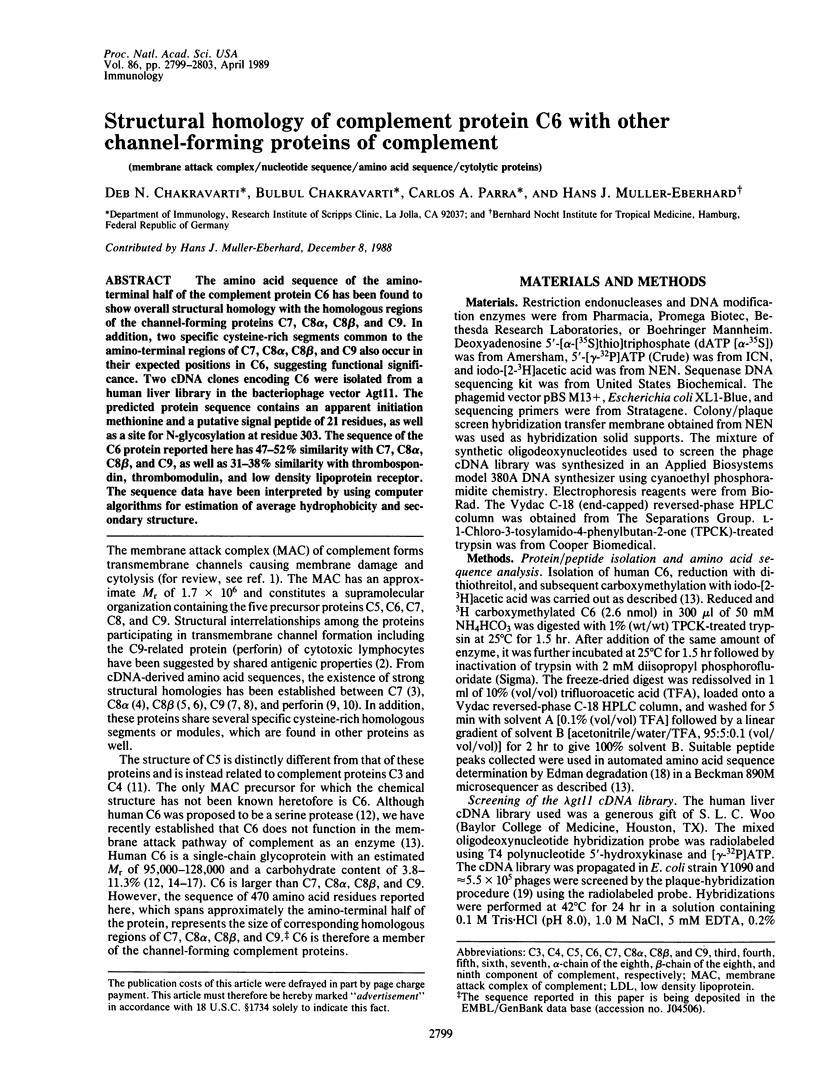
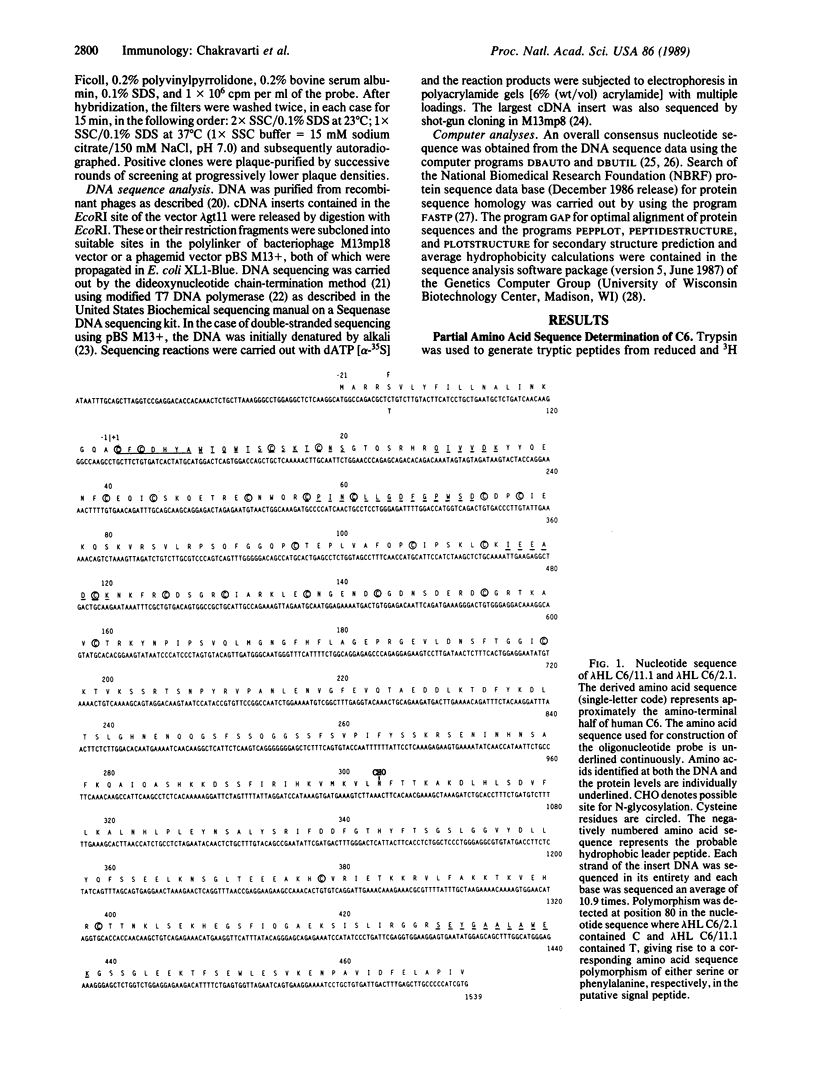
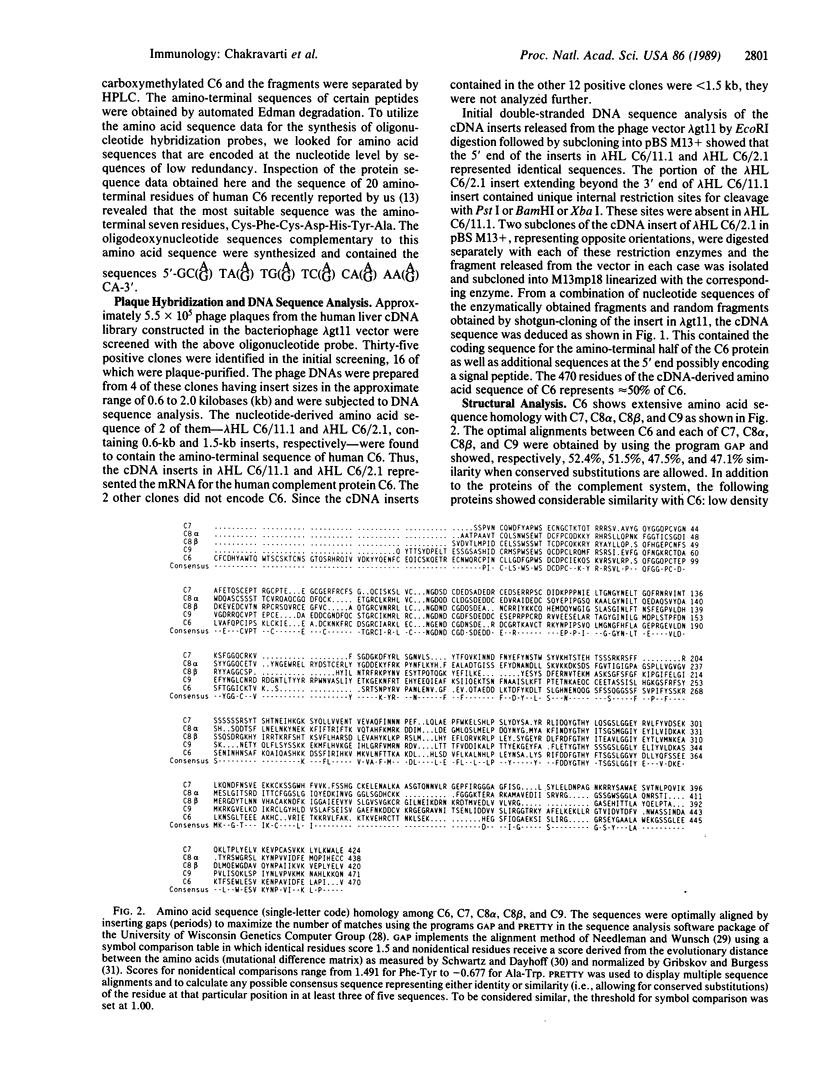
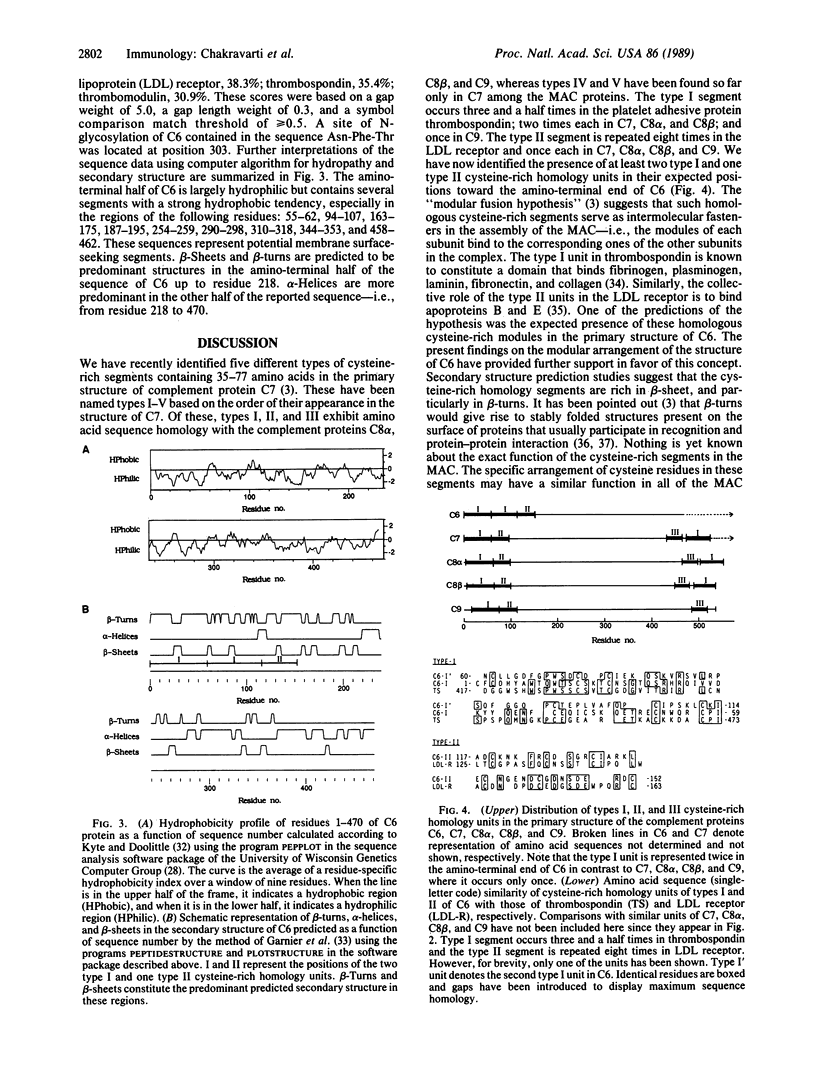
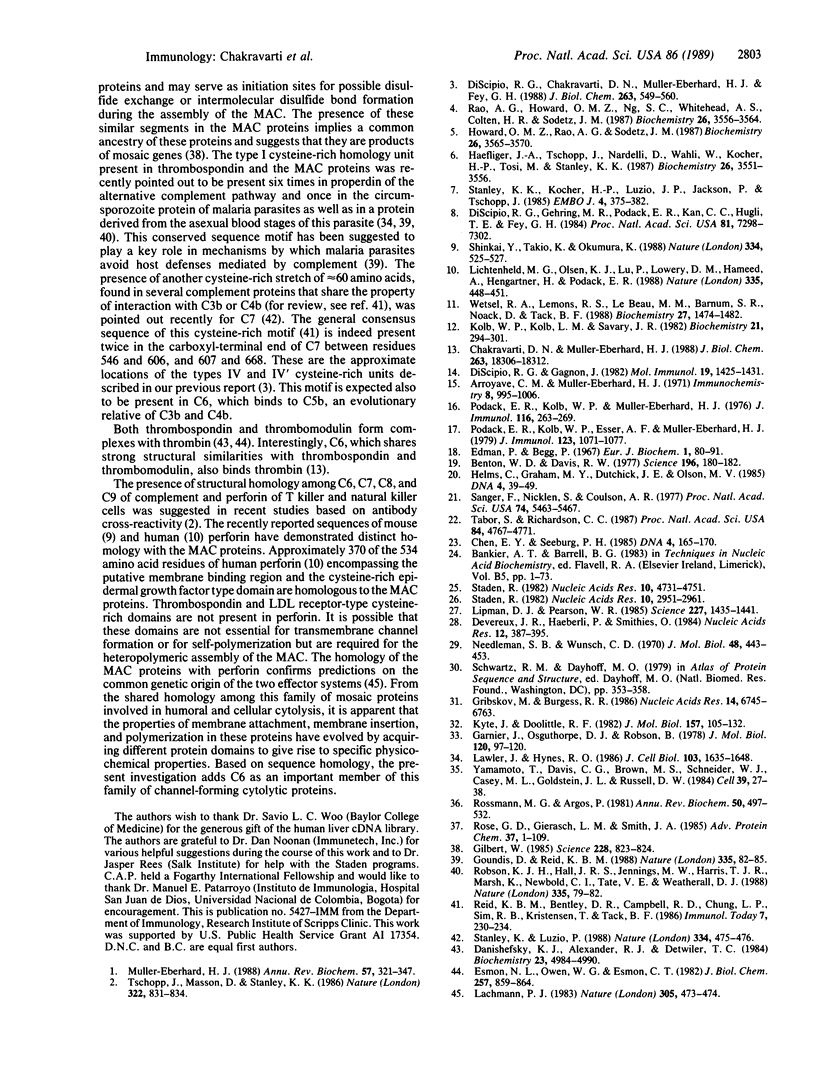
Selected References
These references are in PubMed. This may not be the complete list of references from this article.
- Arroyave C. M., Müller-Eberhard H. J. Isolation of the sixth component of complement from human serum. Immunochemistry. 1971 Nov;8(11):995–1006. doi: 10.1016/0019-2791(71)90487-3. [DOI] [PubMed] [Google Scholar]
- Benton W. D., Davis R. W. Screening lambdagt recombinant clones by hybridization to single plaques in situ. Science. 1977 Apr 8;196(4286):180–182. doi: 10.1126/science.322279. [DOI] [PubMed] [Google Scholar]
- Chakravarti D. N., Muller-Eberhard H. J. Biochemical characterization of the human complement protein C6. Association with alpha-thrombin-like enzyme and absence of serine protease activity in cytolytically active C6. J Biol Chem. 1988 Dec 5;263(34):18306–18312. [PubMed] [Google Scholar]
- Chen E. Y., Seeburg P. H. Supercoil sequencing: a fast and simple method for sequencing plasmid DNA. DNA. 1985 Apr;4(2):165–170. doi: 10.1089/dna.1985.4.165. [DOI] [PubMed] [Google Scholar]
- Danishefsky K. J., Alexander R. J., Detwiler T. C. Formation of a stable complex of thrombin and the secreted platelet protein glycoprotein G (thrombin-sensitive protein, thrombospondin) by thiol-disulfide exchange. Biochemistry. 1984 Oct 9;23(21):4984–4990. doi: 10.1021/bi00316a024. [DOI] [PubMed] [Google Scholar]
- Devereux J., Haeberli P., Smithies O. A comprehensive set of sequence analysis programs for the VAX. Nucleic Acids Res. 1984 Jan 11;12(1 Pt 1):387–395. doi: 10.1093/nar/12.1part1.387. [DOI] [PMC free article] [PubMed] [Google Scholar]
- DiScipio R. G., Chakravarti D. N., Muller-Eberhard H. J., Fey G. H. The structure of human complement component C7 and the C5b-7 complex. J Biol Chem. 1988 Jan 5;263(1):549–560. [PubMed] [Google Scholar]
- DiScipio R. G., Gehring M. R., Podack E. R., Kan C. C., Hugli T. E., Fey G. H. Nucleotide sequence of cDNA and derived amino acid sequence of human complement component C9. Proc Natl Acad Sci U S A. 1984 Dec;81(23):7298–7302. doi: 10.1073/pnas.81.23.7298. [DOI] [PMC free article] [PubMed] [Google Scholar]
- Discipio R. G., Gagnon J. Characterization of human complement components C6 and C7. Mol Immunol. 1982 Nov;19(11):1425–1431. doi: 10.1016/0161-5890(82)90189-4. [DOI] [PubMed] [Google Scholar]
- Edman P., Begg G. A protein sequenator. Eur J Biochem. 1967 Mar;1(1):80–91. doi: 10.1007/978-3-662-25813-2_14. [DOI] [PubMed] [Google Scholar]
- Esmon N. L., Owen W. G., Esmon C. T. Isolation of a membrane-bound cofactor for thrombin-catalyzed activation of protein C. J Biol Chem. 1982 Jan 25;257(2):859–864. [PubMed] [Google Scholar]
- Garnier J., Osguthorpe D. J., Robson B. Analysis of the accuracy and implications of simple methods for predicting the secondary structure of globular proteins. J Mol Biol. 1978 Mar 25;120(1):97–120. doi: 10.1016/0022-2836(78)90297-8. [DOI] [PubMed] [Google Scholar]
- Gilbert W. Genes-in-pieces revisited. Science. 1985 May 17;228(4701):823–824. doi: 10.1126/science.4001923. [DOI] [PubMed] [Google Scholar]
- Goundis D., Reid K. B. Properdin, the terminal complement components, thrombospondin and the circumsporozoite protein of malaria parasites contain similar sequence motifs. Nature. 1988 Sep 1;335(6185):82–85. doi: 10.1038/335082a0. [DOI] [PubMed] [Google Scholar]
- Gribskov M., Burgess R. R. Sigma factors from E. coli, B. subtilis, phage SP01, and phage T4 are homologous proteins. Nucleic Acids Res. 1986 Aug 26;14(16):6745–6763. doi: 10.1093/nar/14.16.6745. [DOI] [PMC free article] [PubMed] [Google Scholar]
- Haefliger J. A., Tschopp J., Nardelli D., Wahli W., Kocher H. P., Tosi M., Stanley K. K. Complementary DNA cloning of complement C8 beta and its sequence homology to C9. Biochemistry. 1987 Jun 16;26(12):3551–3556. doi: 10.1021/bi00386a045. [DOI] [PubMed] [Google Scholar]
- Helms C., Graham M. Y., Dutchik J. E., Olson M. V. A new method for purifying lambda DNA from phage lysates. DNA. 1985 Feb;4(1):39–49. doi: 10.1089/dna.1985.4.39. [DOI] [PubMed] [Google Scholar]
- Howard O. M., Rao A. G., Sodetz J. M. Complementary DNA and derived amino acid sequence of the beta subunit of human complement protein C8: identification of a close structural and ancestral relationship to the alpha subunit and C9. Biochemistry. 1987 Jun 16;26(12):3565–3570. doi: 10.1021/bi00386a047. [DOI] [PubMed] [Google Scholar]
- Kolb W. P., Kolb L. M., Savary J. R. Biochemical characterization of the sixth component (C6) of human complement. Biochemistry. 1982 Jan 19;21(2):294–301. doi: 10.1021/bi00531a015. [DOI] [PubMed] [Google Scholar]
- Kyte J., Doolittle R. F. A simple method for displaying the hydropathic character of a protein. J Mol Biol. 1982 May 5;157(1):105–132. doi: 10.1016/0022-2836(82)90515-0. [DOI] [PubMed] [Google Scholar]
- Lachmann P. J. Are complement lysis and lymphocytotoxicity analogous? Nature. 1983 Oct 6;305(5934):473–474. doi: 10.1038/305473a0. [DOI] [PMC free article] [PubMed] [Google Scholar]
- Lawler J., Hynes R. O. The structure of human thrombospondin, an adhesive glycoprotein with multiple calcium-binding sites and homologies with several different proteins. J Cell Biol. 1986 Nov;103(5):1635–1648. doi: 10.1083/jcb.103.5.1635. [DOI] [PMC free article] [PubMed] [Google Scholar]
- Lichtenheld M. G., Olsen K. J., Lu P., Lowrey D. M., Hameed A., Hengartner H., Podack E. R. Structure and function of human perforin. Nature. 1988 Sep 29;335(6189):448–451. doi: 10.1038/335448a0. [DOI] [PubMed] [Google Scholar]
- Lipman D. J., Pearson W. R. Rapid and sensitive protein similarity searches. Science. 1985 Mar 22;227(4693):1435–1441. doi: 10.1126/science.2983426. [DOI] [PubMed] [Google Scholar]
- Müller-Eberhard H. J. Molecular organization and function of the complement system. Annu Rev Biochem. 1988;57:321–347. doi: 10.1146/annurev.bi.57.070188.001541. [DOI] [PubMed] [Google Scholar]
- Needleman S. B., Wunsch C. D. A general method applicable to the search for similarities in the amino acid sequence of two proteins. J Mol Biol. 1970 Mar;48(3):443–453. doi: 10.1016/0022-2836(70)90057-4. [DOI] [PubMed] [Google Scholar]
- Podack E. R., Kolb W. P., Esser A. F., Müller-Eberhard H. J. Structural similarities between C6 and C7 of human complement. J Immunol. 1979 Sep;123(3):1071–1077. [PubMed] [Google Scholar]
- Podack E. R., Kolb W. P., Müller-Eberhard H. J. Purification of the sixth and seventh component of human complement without loss of hemolytic activity. J Immunol. 1976 Feb;116(2):263–269. [PubMed] [Google Scholar]
- Rao A. G., Howard O. M., Ng S. C., Whitehead A. S., Colten H. R., Sodetz J. M. Complementary DNA and derived amino acid sequence of the alpha subunit of human complement protein C8: evidence for the existence of a separate alpha subunit messenger RNA. Biochemistry. 1987 Jun 16;26(12):3556–3564. doi: 10.1021/bi00386a046. [DOI] [PubMed] [Google Scholar]
- Robson K. J., Hall J. R., Jennings M. W., Harris T. J., Marsh K., Newbold C. I., Tate V. E., Weatherall D. J. A highly conserved amino-acid sequence in thrombospondin, properdin and in proteins from sporozoites and blood stages of a human malaria parasite. Nature. 1988 Sep 1;335(6185):79–82. doi: 10.1038/335079a0. [DOI] [PubMed] [Google Scholar]
- Rose G. D., Gierasch L. M., Smith J. A. Turns in peptides and proteins. Adv Protein Chem. 1985;37:1–109. doi: 10.1016/s0065-3233(08)60063-7. [DOI] [PubMed] [Google Scholar]
- Rossmann M. G., Argos P. Protein folding. Annu Rev Biochem. 1981;50:497–532. doi: 10.1146/annurev.bi.50.070181.002433. [DOI] [PubMed] [Google Scholar]
- Sanger F., Nicklen S., Coulson A. R. DNA sequencing with chain-terminating inhibitors. Proc Natl Acad Sci U S A. 1977 Dec;74(12):5463–5467. doi: 10.1073/pnas.74.12.5463. [DOI] [PMC free article] [PubMed] [Google Scholar]
- Shinkai Y., Takio K., Okumura K. Homology of perforin to the ninth component of complement (C9). Nature. 1988 Aug 11;334(6182):525–527. doi: 10.1038/334525a0. [DOI] [PubMed] [Google Scholar]
- Staden R. An interactive graphics program for comparing and aligning nucleic acid and amino acid sequences. Nucleic Acids Res. 1982 May 11;10(9):2951–2961. doi: 10.1093/nar/10.9.2951. [DOI] [PMC free article] [PubMed] [Google Scholar]
- Staden R. Automation of the computer handling of gel reading data produced by the shotgun method of DNA sequencing. Nucleic Acids Res. 1982 Aug 11;10(15):4731–4751. doi: 10.1093/nar/10.15.4731. [DOI] [PMC free article] [PubMed] [Google Scholar]
- Stanley K. K., Kocher H. P., Luzio J. P., Jackson P., Tschopp J. The sequence and topology of human complement component C9. EMBO J. 1985 Feb;4(2):375–382. doi: 10.1002/j.1460-2075.1985.tb03639.x. [DOI] [PMC free article] [PubMed] [Google Scholar]
- Stanley K., Luzio P. Perforin. A family of killer proteins. Nature. 1988 Aug 11;334(6182):475–476. doi: 10.1038/334475a0. [DOI] [PubMed] [Google Scholar]
- Tabor S., Richardson C. C. DNA sequence analysis with a modified bacteriophage T7 DNA polymerase. Proc Natl Acad Sci U S A. 1987 Jul;84(14):4767–4771. doi: 10.1073/pnas.84.14.4767. [DOI] [PMC free article] [PubMed] [Google Scholar]
- Tschopp J., Masson D., Stanley K. K. Structural/functional similarity between proteins involved in complement- and cytotoxic T-lymphocyte-mediated cytolysis. 1986 Aug 28-Sep 3Nature. 322(6082):831–834. doi: 10.1038/322831a0. [DOI] [PubMed] [Google Scholar]
- Wetsel R. A., Lemons R. S., Le Beau M. M., Barnum S. R., Noack D., Tack B. F. Molecular analysis of human complement component C5: localization of the structural gene to chromosome 9. Biochemistry. 1988 Mar 8;27(5):1474–1482. doi: 10.1021/bi00405a012. [DOI] [PubMed] [Google Scholar]
- Yamamoto T., Davis C. G., Brown M. S., Schneider W. J., Casey M. L., Goldstein J. L., Russell D. W. The human LDL receptor: a cysteine-rich protein with multiple Alu sequences in its mRNA. Cell. 1984 Nov;39(1):27–38. doi: 10.1016/0092-8674(84)90188-0. [DOI] [PubMed] [Google Scholar]


